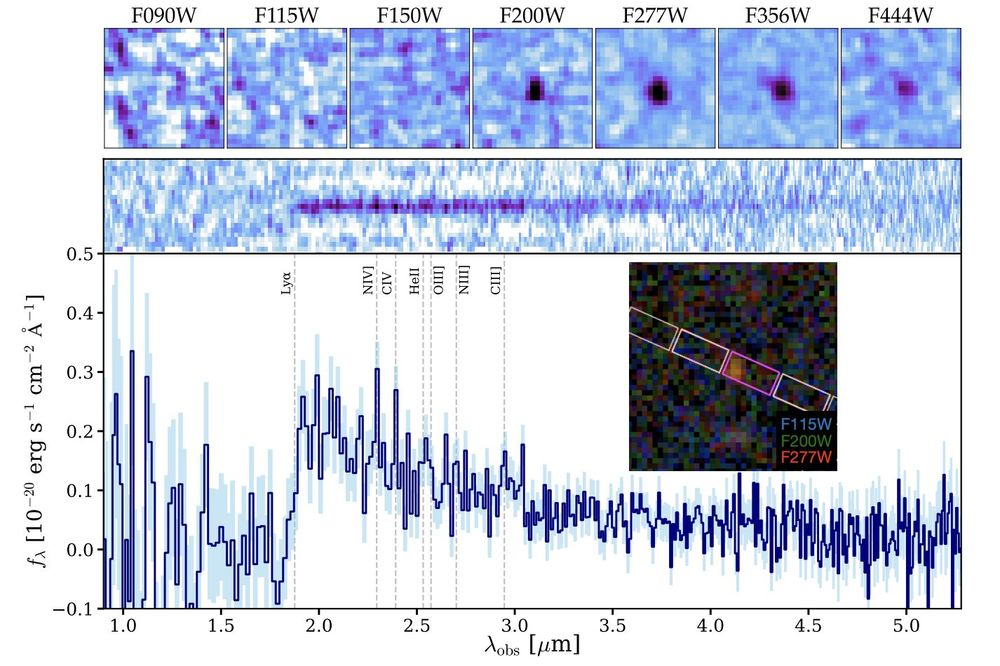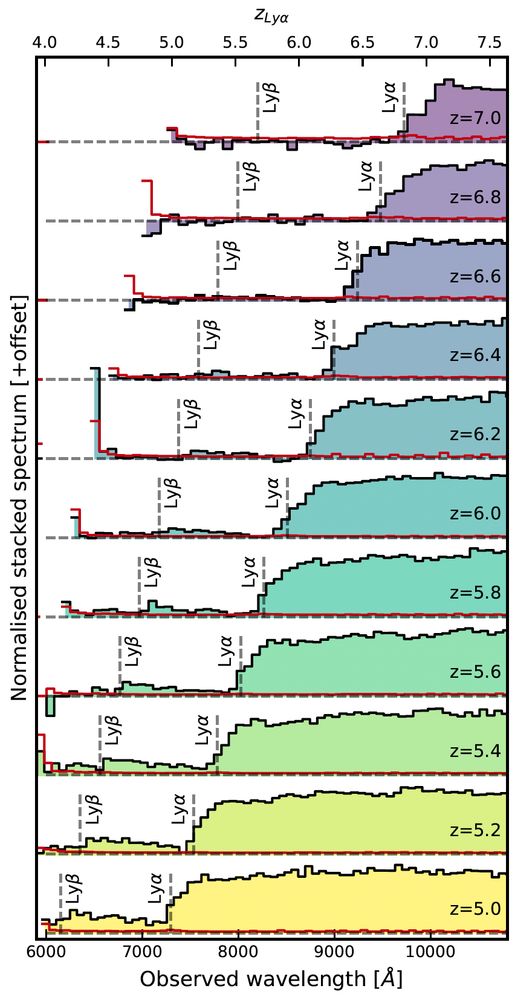A delayed announcement - the 2nd chapter of the Saas-Fee 2025 Lectures is now out on arXiv. Marta Volonteri did a fantastic job reviewing how we model the formation and growth of early massive black holes, and how JWST results are helping: arxiv.org/abs/2510.04599 (another 2 chapters will follow)
07.11.2025 10:01 — 👍 3 🔁 0 💬 0 📌 0
Quand notre ministre de tutelle nous insulte devant la représentation nationale. "Bande de nuls" "complètement à la ramasse".
Nous reprocher des taux de réussite faible à Horizon Europe et ERC, quand manquent les moyens pour assurer nos missions de service public. Surtout changez rien!👌
31.10.2025 08:55 — 👍 395 🔁 203 💬 38 📌 106

A series of wispy, blue strands emanate from the centre of the image, which is glowing orangey–red with a little pink. The background is FESTOONED with stars, all set against a black backdrop.
Another STUNNING image from JWST, this time of the Red Spider Nebula—the vast, wispy, gaseous remains of a now-dead star, the white dwarf core still glowing in the centre.
28.10.2025 17:59 — 👍 590 🔁 166 💬 6 📌 12
I can't assess whether the number and ionising output of the PopIII.1 / SMBH progenitors would be enough.. But I note that in the z=20 Flash model, the ionised fraction is 10% at z=14, which we could soon measure with Lyman-alpha/damping wings with JWST. The z=25 scenario is much harder to rule out!
24.10.2025 07:32 — 👍 2 🔁 0 💬 1 📌 0
In short, there is now a patch of the sky the size of the full moon for which we know the 3D structure of all luminous* galaxies at a time when the Universe was basically a toddler!
21.10.2025 06:27 — 👍 2 🔁 0 💬 2 📌 0
Usually confirming distant galaxies is hard and can only be done in very small fields. This field (COSMOS) is roughly the size of the *full moon* - pretty big by extragalactic standard. Also notable here is the use of a specific JWST instrument to confirm *all* galaxies in one go in that field.
21.10.2025 06:27 — 👍 2 🔁 0 💬 1 📌 0
Thanks! Here would be a jargon-free version: Thanks to #JWST we have precisely mapped the location of 237 galaxies so distant we see them as they are 0.5-0.8 Billion years after the Big Bang (we are a +13.7 billion years - their light travelled 13 billion years to reach us!).
21.10.2025 06:27 — 👍 2 🔁 0 💬 1 📌 0
#extragalactic #astrosci
17.10.2025 14:41 — 👍 9 🔁 1 💬 0 📌 0

The paper focuses on the OIII luminosity function and the fact that with 0.3 degree squares, we can finally beat down cosmic variance (but only to 15% relative uncertainty). You need wide-area surveys to sample all environments - something difficult with JWST. Lot of structure even in COSMOS 👇
17.10.2025 14:37 — 👍 4 🔁 0 💬 1 📌 0

You probably missed it because of some deadline but on Tuesday we published the results of an [OIII] emitters search in the COMOS(-3D) field using slitlless spectroscopy. That's *237* 6.7<z<9 uniformly-selected spec-z galaxies over 0.3 degrees square. See the piled 2D plots below, that's a lot!
17.10.2025 14:33 — 👍 12 🔁 3 💬 2 📌 1

Galaxies and Black Holes in the First Billion Years
I present written notes from three lectures given at the 54th Saas-Fee Advanced Course of the Swiss Society of Astrophysics and Astronomy in January 2025 entitled "Galaxies and Black Holes in the Firs...
On astro-ph today, a nice set of lecture notes from Richard Ellis (UCL) on Galaxies and Black Holes in the first Billion years - with special focus on new results from JWST. It also illustrates why MIRI is essential for accurately estimating galaxies' stellar masses ✨ arxiv.org/abs/2508.16948 🔭
27.08.2025 01:12 — 👍 24 🔁 3 💬 1 📌 0
This is an excellent intro read for students and other interested folks, especially including discussing the pre-JWST era and the historical perspective in extragalactic astronomy over 2-5 decades. #astronomy #extragalactic #jwst
26.08.2025 08:10 — 👍 2 🔁 0 💬 0 📌 0

Galaxies and Black Holes in the First Billion Years
I present written notes from three lectures given at the 54th Saas-Fee Advanced Course of the Swiss Society of Astrophysics and Astronomy in January 2025 entitled "Galaxies and Black Holes in the Firs...
In January we held the very successful Saas-Fee Lectures on the revolution JWST is unleashing in high-redshift studies, covering BH and galaxies, observations and theory.
The first set of lecture notes by Richard Ellis is now available on arXiv (3 more will follow): arxiv.org/abs/2508.16948 .
26.08.2025 08:08 — 👍 7 🔁 1 💬 1 📌 1

Charting Cosmic Dawn in Copenhagen 2026 - Cosmic Dawn Center
An overview of the 2026 workshop "Charting Cosmic Dawn in Copenhagen."
We are excited to make the first official announcement for the 𝗖𝗵𝗮𝗿𝘁𝗶𝗻𝗴 𝗖𝗼𝘀𝗺𝗶𝗰 𝗗𝗮𝘄𝗻 conference in Copenhagen in 12–17 April next year 🤩
cosmicdawn.dk/meetings-and...
13.08.2025 12:40 — 👍 5 🔁 2 💬 1 📌 1

Extremely excited to share that the PHOENIX team, led by PhD student Sander Schouws in Leiden, has been awarded 113 hours of ALMA time in Cycle 12—along with JWST MIRI spectroscopy! We’ll be targeting [OIII]88 and the dust continuum in 15 of the brightest spectroscopically confirmed galaxies 1/n
07.08.2025 15:25 — 👍 2 🔁 1 💬 1 📌 0
and once again, the JWST call for proposal is in exact sync with the ERC StG deadline.. 🥲
08.07.2025 13:52 — 👍 1 🔁 0 💬 0 📌 0

We found the most distant confirmed galaxy
(some Sergej Boebka vibes 😅)
arxiv.org/abs/2505.11263
19.05.2025 06:42 — 👍 48 🔁 15 💬 0 📌 6
@bot.astronomy.blue signup
06.04.2025 18:33 — 👍 2 🔁 0 💬 1 📌 0
It's been enormous fun working on this with my three co-authors, using the impressive sensitivity of #JWST to do something I sincerely had not foreseen was possible pre-launch. I hope that many of my high-z galaxy colleagues will be tempted to dip in IGM science now!
04.04.2025 13:32 — 👍 0 🔁 0 💬 0 📌 0

Furthermore, we find that both environmental (local galaxy overdensity measured from FRESCO/JADES) and intrinsic (high ionising output/escape) effects are needed to explain the low opacity, and, in turn, the large number of LAEs detected by JADES. The local "ionisation budget" checks out!
04.04.2025 13:32 — 👍 2 🔁 1 💬 1 📌 0


We illustrate the latter point in GOODS-South at z=5.8-5.9 where @joriswitstok.bsky.social et al. reported a large number of Lyman-alpha emitters, a line normally suppressed by the neutral IGM. We can explain this as the IGM there is in the top 4-7th percentile of most transparent regions at z=5.9!
04.04.2025 13:32 — 👍 1 🔁 0 💬 1 📌 0
3) You can also detect the Lyman-beta(gamma?) forest and accurately subtract the foreground Lyman-alpha (see paper) 4) Finally we can take the galaxy/AGN population in a given field, and see if their ionising output checks out with the IGM opacity locally - a great step for reionisation studies!
04.04.2025 13:32 — 👍 0 🔁 0 💬 1 📌 0
This is extremely exciting for many reasons: 1) unlike quasars, the supply of luminous galaxies is virtually unlimited. Either by stacking faint objects or specially targetting luminous galaxies, you can get a signal 2) Thus any field you observe with NIRSpec MSA is good for this measurement!!
04.04.2025 13:32 — 👍 0 🔁 0 💬 1 📌 0


In principle you could use galaxies to detect the Lyman-alpha forest z~6, but this is extremely challenging with ground-based observatories. Enter #JWST!! By stacking public spectra of z>5 galaxies in the archive, we finally detect the GP trough in high-redshift galaxies. It's beautiful!
04.04.2025 13:32 — 👍 0 🔁 0 💬 1 📌 0
It’s extremely annoying (at least to me) that we measure the IGM opacity in quasar sightlines but then study the sources of reionisation in HST/JWST extragalactic deep fields, and then try to reconcile both measurements in a global, Universe-average “reionisation budget of ionising photons”.
04.04.2025 13:32 — 👍 0 🔁 0 💬 1 📌 0


Since then the GP trough and more generally the IGM opacity measurements made from z~6 quasar Lyman-alpha forest have set great constraints on the timing and topology of reionisation (e.g. Eilers+18, below). The drawback is that such luminous quasars are extremely rare (~0.5 / deg^2).
04.04.2025 13:32 — 👍 0 🔁 0 💬 1 📌 0

The Gunn-Peterson trough is the full absorption of the Lyman-alpha forest when the IGM becomes ever-so-slightly neutral, signalling the end of reionisation. It was predicted in 1965 but took ~35 years to be observed in z~6 quasars discovered with SDSS (e.g. Becker+2001 below).
04.04.2025 13:32 — 👍 0 🔁 0 💬 1 📌 0


🧵 Today is paper day for me! Usually I don’t post about papers but I have a special soft spot for this one: the detection of the Gunn-Peterson trough in high-redshift *galaxies* !!
arxiv.org/abs/2504.02683
#astrosci #extragalactic #cosmology
04.04.2025 13:32 — 👍 23 🔁 4 💬 1 📌 1
Dad. Author of the Cosmic Collisions books. Astrophysicist and Citizen Science fanatic @nasa. www.marckuchner.com
Astrophysics PhD Student at Lancaster University
Official account for Monthly Notices of the Royal Astronomical Society (MNRAS), Geophysical Journal International (GJI) and RAS Techniques and Instruments (RASTI). See also https://academic.oup.com/rasjournals
Staff Astronomer @ a place - Exoplanet Atmospheres with JWST. All data is good data.
Plus Knitting, Stickers, Baking, and other crafty things. Toddler mom.
Known as @_astronoMay on other sites
ErinMMay.com
SiderealStickers.Etsy.com
The Cosmic Dawn Center (DAWN) DAWN is a collaboration between the Niels Bohr Institute (U. Cph) and DTU Space, dedicated to uncovering how the first galaxies, stars and black holes formed and evolved in the early Universe.
The Swiss National Science Foundation funds excellent research at universities and other institutions – from chemistry to medicine to sociology.
We invest in researchers and their ideas 🔬🌱📚 — www.snf.ch/en
Deutsch & Français: @snf-fns.ch
Menswear writer. Editor at Put This On. Words at The New York Times, The Washington Post, The Financial Times, Esquire, and Mr. Porter.
If you have a style question, search:
https://dieworkwear.com/ | https://putthison.com/start-here/
I'm an astronomer working with ALMA on the destruction and chemistry of protoplanetary disks. Currently a postdoc at the IWF and no longer living from boxes!
Reader in observational astrophysics. Parent. From Amsterdam, living in Liverpool <3
Compte officiel de la Société Française d'Astronomie et d'Astrophysique
Keeping you posted on space science activities from the European Space Agency.
Web: http://www.esa.int/science
Privacy Notice: esa.int/connectwithus
#astronomy #space #science
Astrophysicist at NASA Goddard Space Flight Center.
Gym, books & board games geek. Love solving probability problems too.
From Málaga. Living in Washington DC.
parrabalharo.com
Figuring out some of the mysteries of the Universe from Chile at simonsobservatory.org
#50YearsOfESA: we're the European Space Agency, keeping you posted on European space activities.
Please see our Privacy Notice: https://esa.int/connectwithus
Choose a better internet where privacy is the default. Start protecting your personal information online with Proton Mail, Proton VPN, Proton Drive, Proton Pass, Proton Wallet.
For more frequent updates, follow us here: reddit.com/r/ProtonMail
i do astro at uni cote d'azur | prev. (astro)physics @ucl @roma2 and rlc @nulondon | science outreach, LEGO and handball enthusiast
Assistant Professor at the Niels Bohr Institute / University of Copenhagen. Studies the formation of primordial galaxies and the chemical enrichment of the Universe
Research, news, and commentary from Nature, the international science journal. For daily science news, get Nature Briefing: https://go.nature.com/get-Nature-Briefing
The European Southern Observatory designs, builds & operates world-class observatories on the ground for the benefit of society. More info on eso.org
Astrophysicist at Institut d'Astrophysique de Paris on galaxy formation, cosmology, and high-performance computing.
https://cphyc.github.io


















